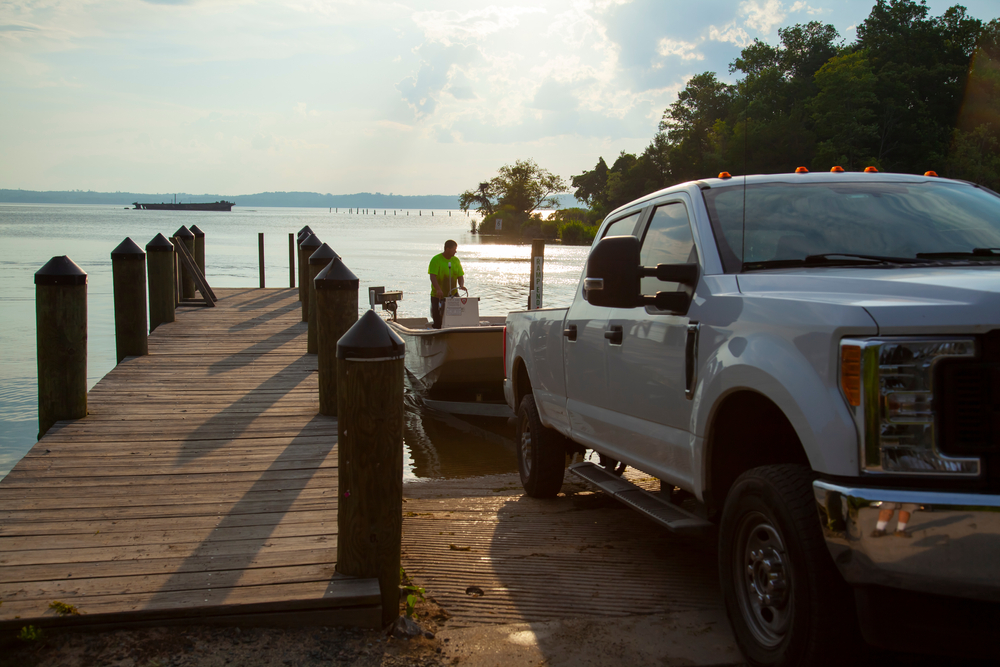
The Ford F-150 has a reputation of being a workhorse with a best-in-class maximum towing capacity of 14,000 lbs. Deciding which one will suit you comes to down to having the correct information, knowing what your needs will be and then comparing.
Many people buy a pickup truck because they need something that has towing capacity. Whether it’s a boat for a family fun day on the lake or an everyday work-related trailer, pickup trucks are built to haul items safely. But what kind of truck should you consider?
You’ll need to consider how much weight you want your truck to pull, as well as what your bank account can afford. Keep in mind that auto insurance is higher for heavy-duty trucks, since they have the capability of causing more damage in a wreck and cost more to repair and replace.
Other things to consider include what the inventory is and whether the truck you want is in stock. Will you need to drive to a different location to find the one that you want to test drive? Will your dealership promise delivery on a reasonable date? What’s in your price range? Will you be towing a fifth-wheel trailer, a boat or heavy loads for work on a daily basis? What is the maximum amount of weight you need to tow?
All of the answers to these questions can help you compare the different vehicles on the market. Let’s take a look at the towing capacity of the Ford F-150 in particular. New Ford F-150s compete on an equal stage with other well-known towing trucks, such as the Chevrolet Silverado.
Understanding Towing Capacity
Towing capacity is how much weight you can safely and legally pull behind your pickup. When you figure out the weight of the load you are towing, you must factor in the weight of the truck itself and anything you have in the bed to arrive at the maximum weight. When you tow more than the amount your vehicle is advertised at, you can create an unsafe situation, as well as damage your pickup’s various components, such as the engine, transmission, tires, brakes and more.
Keep in mind that dealership advertised towing capacity is based on an empty vehicle with only a driver and no other load. You can check with the Society of Automotive Engineers (SAE) J2807 standard for a more realistic towing capacity of your specific model or see below for how to determine your max towing capacity yourself. To do this, you will need:
- Curb weight: the weight when empty but with a full tank of gas and topped off fluids.
- Gross Vehicle Weight Rating (GVWR): How much your truck can carry inside (driver, passengers and cargo).
- Gross Combined Vehicle Weight Rating (GCVWR): Total weight amount for loaded truck plus trailer.
- Trailer Tongue Weight: This should be included in your payload number and measures how much weight your towed load puts on your vehicle’s hitch.
Don’t depend completely on the accuracy of the information provided by the dealership.
Factors Influencing Towing Capacity
There are many factors that influence the towing capacity of your model. These include things like the configuration of your vehicle (size, weight and how that’s distributed), transmission (automatic is better), your vehicle’s specs (found in your owner’s manual), tires (narrow and short for increased torque) and more.
Don’t be confused between payload capacity and towing ability. Your payload is the amount you can load in the cargo area, while towing capacity is how many pounds you can pull behind.
Engine Power and Torque
Have you wondered why diesel engines are more favored when it comes to towing? That’s because they provide more torque. Torque is more important when it comes to this business than horsepower because a higher torque will put less strain on your engine when hefting a load.
Your engine’s horsepower is also important as it makes your vehicle go fast when needed – such as when passing another automobile. Both enough horsepower and a high torque are critical for towing.
Transmission and Drivetrain
As mentioned, most prefer an automatic transmission over standard when pulling a load. This is because an automatic tranny can handle heavier loads. Similarly, two-wheel drive with rear-wheel drivetrains are more preferred since they tend to be more fuel efficient.
Suspension and Braking Systems
Your suspension system plays a large part in determining how much you can pull. After all, if the back end of your vehicle is sitting on the ground after you hook up an RV, there’s obviously a problem. Similarly, you certainly don’t want to have a runaway truck situation because your vehicle does not have enough brake capacity to stop the load behind.
You can upgrade both of these components aftermarket in order to have a higher capacity.

Towing Capacity of Ford F-150
The maximum ability of the Ford F-150 to heft the heaviest loads is well known. Each model comes with different specifications and limits, so you can pick the one that best suits your needs.
Variations in Towing Capacity Based on Configuration
Your truck’s configuration plays a large part in towing capacity. The configuration is the hardware of the vehicle, including the engine type, transmission, height, weight, length, axle spacing and more. Each of these components bears on your max capability.
Different Engine Options and Their Impact on Towing Capacity
The Ford F-150 2023 lineup includes several model options with a variety of towing capacity.
- 3.3L Ti-VCT V6 Engine: 8,200-pound maximum towing capacity
- 2.7L EcoBoost® V6 Engine: 10,000-pound maximum towing capacity
- 5.0L Ti-VCT V8 Engine: 13,000-pound maximum towing capacity
- 3.5L EcoBoost® V6 Engine: 14,000-pound maximum towing capacity
- 3.5L PowerBoost™ Full Hybrid V6 Engine: 12,700-pound maximum towing capacity
- High-Output 3.5L EcoBoost® Engine: 8,200-pound maximum towing capacity
- High-Output Supercharged 5.2L V8 Engine: 8,200-pound maximum towing capacity
Last year’s electric F-150 Lightning still offers an impressive package, with a max estimated tow ability of 14,000 lbs with the turbocharged 3.5L EcoBoost® V6.
Effects of Optional Towing Packages or Upgrades
Your 2023 Ford F-150 is a powerful machine, but you can opt to spend slightly more and equip it with the max trailer tow package. This extra can be added to the Lariat, King Ranch and Platinum F-150 models. With this, you’ll get a better towing experience if you need it. Included are things such as a larger gas tank for more miles, a class 4 hitch receiver, pro trailer backup assist, Blind Spot Information System, and more.
Similarly, you can choose to upgrade your pickup with aftermarket parts, such as a better hitch, more power in braking with a brake controller, better suspension with air bags, and more.
Consideration of Additional Factors
Trailer hitches come in different classes and have their own specs when it comes to weight constraints. With your F-150, you’ll want to stay in the Class III to Class V which are designed specifically for larger trucks pulling more pounds. Here are some examples of what you can tow in these three classes.
- Class III: Midsize camper or boat
- Class IV: Large boat, larger camper, utility trailer with a heavy load
- Class V: Horse trailer, multi-car trailer
You can add a trailer brake controller that will allow you to send more power to your trailer’s braking system. There are a variety of options so you can choose the one that works best for you.
Determining the Maximum Towing Capacity
Since manufacturers calculate their advertised towing capacity with an empty vehicle and a 150-lb driver, you may want to calculate your own. Using the figures we discussed above, here is the formula: GCVWR – curb weight = maximum towing capacity.
Keep in mind this calculation does not take into consideration passenger and cargo weight. In order to arrive at the best possible weight estimate, subtract these numbers as well. Always stay within 10% of the towing capacity you arrive at with this calculation.
Here is how much some common items weigh. Remember, buy about 15% more capacity than you need.
- Towing a small trailer or boat: You’ll need to be able to tow up to 8,000 pounds for an large sailboat and 16,000 lbs for a cabin cruiser, but your average fishing boat is around 300-500 lbs, while a wake boat runs 3,000 to 5,000 lbs.
- Towing a camper or RV: On average, RV’s weigh about 10,000 lbs while a pop-up camper weighs considerably less at 1,800 to 2,000 lbs.
- Towing heavy equipment or livestock: Heavy when empty at up to 11,000 pounds, when full of livestock, these loads can weigh around 24,000 lbs.
Understanding Insurance Requirements for Towing
If you are towing a small utility trailer, you may be covered for damage you cause in an accident that’s your fault under your liability auto vehicle policy. However, the contents of the trailer are a different matter. Always check with your agent to find out what is and isn’t covered before you hit the road.
In the case of a utility or pop-up camper trailer, you may need to add an endorsement to your policy or buy a separate policy. If you towing a boat, you can purchase insurance for the trailer under your watercraft insurance.
If you are using your trailer for commercial purposes (even if you are just moving livestock around), you’ll most likely need to purchase commercial truck insurance.
Get Affordable Ford Truck and Trailer Insurance Online Today
Before you take your Ford F-150 on the road while towing a load, get in touch with an independent agent at Freeway Insurance. We can help you compare quotes in a matter of minutes. Just reach out to us online, give us a call at (800) 777-5620 or stop by one of our convenient locations.


